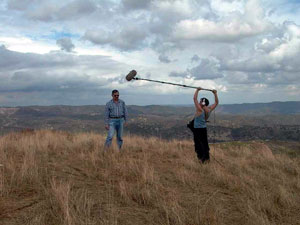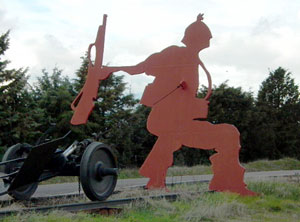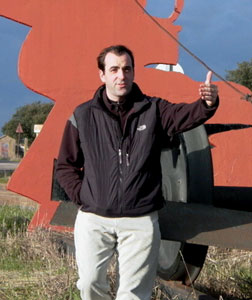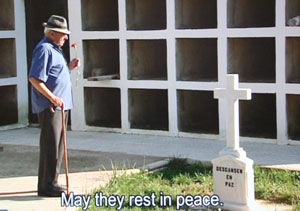 |
→ April 2005 Contents → Column
|
Heroes Never Die
|
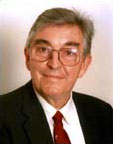 |
||||||||||||||||||||||||||||||||||||
|
A Death in the Afternoon
“Even when the voices and recollections of witnesses have been extinguished, photographs will continue to illuminate our memories …”
The 48 men and two women of the militia unit stirred in the trenches that stretched across a grassy knoll above the village of Cerro Muriano. Siesta was over.
In the distance the skyline of Cordoba could be made out. In front were craggy mountains and deep gorges, where snipers were waiting for them.
It was Sept. 5, 1936. The war to defend the Republic of Spain against the right-wing, rebel military was two months old. The militia unit was made up of volunteers, factory workers and farm laborers, mainly from the textile mills of Alcoi near Alicante. They had marched or were driven in open trucks 500 km to the west to reinforce the front line at Cordoba.
Among them was Frederico Borrell Garcia, a worker from the El Molinar textile factory in Alcoi, orphaned at an early age, with three brothers and two sisters. Everybody called him ‘Taino.’ As a longtime member of the CNT (the national labor union) he was respected and listened to by his comrades.
The militia had been joined by a young, dark-haired photographer and his woman friend, who also carried cameras.
The photographer, whose camera had frozen the instant moment of Taino’s death on film, lived through the Spanish and many other wars, but it was Taino’s image that made him world-famous: He was Enroe Friedman, from Hungary, who renamed himself Robert Capa. The woman at his side was Gerda Taro. (Robert Capa died in the Indochina War in 1954. His girlfriend Gerda Taro was killed in 1937 during the Spanish Civil War.)
Frederico Borrell ‘Taino’ did not only die that afternoon – traces that he ever existed ended on the hill above Cerro Muriano. His corpse disappeared.
“The death of Frederico Borrell was not recorded in the register of birth, marriages and death,” says José Rafael Llópez Herrador, who is the administrator of the community of Villaharta, where other deaths of the fighting on Sept. 5 at Cerro Muriano are recorded.
It is not known if he ever had a funeral, or where he was buried, presumably in a mass grave. He even lost his name. Robert Capa never wrote his name down, or mentioned it. The last mention of Frederico Borrell is a file notice of the Alcoi Revolutionary Committee in which Taino is mentioned among other casualties for whom payments of soldiers’ wages were to be stopped. Sixty years later the Spanish Civil War historian Mario Brotons gave the name of Frederico Borrell ‘Taino’ to the man in Capa’s photograph.
But is This the True Story?
Truth is the daughter of time
“Thus truth will be the real truth of those that have met their fate in the midst of a storm of resentment and hate, bullets and gunfire such as killed the soldier ‘Taino.’”
“Never accept what you judge to be unacceptable.”
The Spanish documentary “Heroes Never Die,” produced by Jan Arnold, probes deep into the memories of people who knew Frederico Borrell or experienced the 1936-1937 war in Spain. The film also unravels its complex historical and social background.
Who was Frederico Borrell Garcia, called ‘Taino’?
Frederico Borrell Garcia – ‘Taino’ – was born in Benilloba, near Alcoi, Alicante. His father died in 1917, leaving a widow, four sons and two daughters. The family suffered extreme poverty and had to move to Alcoi to survive.
Alfonso Bano Morte, once a friend and co-worker of Frederico Borrell at the El Molinar textile mill in Alcoi and still today an ardent anarchist, says, with some defiance and pride, “Taino belonged to the CNT – always, till the day he died.”
The CNT was the communist-leaning workers’ labor union which had the greatest political influence at the time and led organized resistance against the rebel military.
As a worker Frederico Borrell joined the militia after the July 18, 1936 generals’ coup. “They were not soldiers in the sense that they had been trained properly; they were very strongly committed anarchists who believed in a cause – fighting fascism,” says Alex Kershaw.
A villager from Cerro Muriano, home to the militia group to which Frederico Borrell belonged, remembers them the day they saw combat on Sept. 5, 1936: “ ... the group was completely undisciplined. There was no control; everybody was giving orders. Even with the battlefront here in Cerro Muriano it was all drinking and partying. One carried a bottle of wine and another a whole ham. The militiamen were very brave but also very frightened. When the few Maroccans attacked, the militiamen just should have got them. But they ran all the way down to the cement factory and then everybody just disappeared.” (Most likely Frederico Borrell was already dead at that time.)
Alex Kershaw, a Capa biographer, has his doubts about Robert Capa’s photograph of the ‘falling soldier’:
“There are many theories how this image came to be taken; people have conjected [sic] that it was a man called Frederico Borrell. No one was able to prove that it was that man, nobody was able to prove how exactly that man died; he was never found.
“There is no archival trace of Frederico Borrell, There is nothing written down that it was Frederico Borrell in that image. There is nothing in any archive that says that Frederico Borrell died on this day this famous photograph was supposedly taken.”
Kershaw adds his thoughts about the way the picture was taken: “There are basically two theories: One is that Capa, through a fluke, through an instantaneous reaction, managed to capture in a miraculous moment of time the image of a man being struck by a bullet, the moment of death. It has surprised many people that Capa was not able to name the man in this image. He became world-famous, literally overnight, because of this image. He said he spent a week with the militia to which this man apparently belonged. You think it would be strange to spend so long with this small group of men, having been in combat with them, having seen this man apparently die, he would not ask then at least someone in the militia ‘who was that?’
Ampar Borrell, a niece of Taino (she is the daughter of his brother Everisto) has no such doubts about the identify of the ‘falling soldier.’ “I recognize him; his ears are like my father’s, Everisto Borrell,” she says. “Not probably, I am certain. During his work on the book, Mario Brotons showed me the (Capa) picture. I first thought of my father who had died a few years before. My mother and I cried. Because it was really a powerful image.” Ampar found some photographs of Uncle Taino in the family album for the historian Brotons.
(The official Robert Capa biographer, Richard Whelan, as well as Robert Capa’s editor at Life magazine, John Morris, disagree with Alex Kershaw. For them the picture is real, not staged and the man in the photo is indeed Frederico Borrell. Both did not contribute to the film.)
Francisco Moreno Gomez, a history professor, seems to accept the identity of Frederico Borrell. In his 1986 book La Guerra Civil en Córdoba (The Civil War in Córdoba), he published in the appendix a list of fallen soldiers. The names had been cross-checked in military archives and the archive of the civil war in Salamanca. Taino is among the dead listed.
In 1996 Mario Brotons, the local historian from Alcoi, confirmed that Frederico Borrell is the person in the Capa picture. “This is Taino; I was there in Cerro Muriano together with him,” he stated in 1996. However, Brotons does not appear in any picture from Capa nor is he documented as a fellow militiaman in any other way.
Miguel Pascual Mira, a historian from Alcoi who has explored Frederico Borrell’s case in his voluminous civil war archive in Alcoi, expresses a view that is worthy of Don Quixote: “I am quite sure the picture does not show the death of Taino. I believe it was taken beforehand. This is what makes Capa the greatest. To me the photo has even more merit if it was staged. And when I say staged, I don’t mean faked, because the photograph is real, and shows death. If the image was a question of coincidence anybody could take it. If not, it would take a genius to make it.”
The Invisible Image
It is the particular oddity of this film that Capa’s famous ‘falling soldier’ picture seems present for 87 minutes, but is never shown. As explained during the first minutes in the film:
“The most emblematic image of the Spanish Civil War has been monopolized by a third party. We have not been authorized to include any Robert Capa in this movie.”
This third party is the Magnum Agency, founded by Robert Capa (and Henri Cartier-Bresson, David Seymour and George Rodger), and the administrators of his estate.
However, he used some dramatic substitutes.
A 120-km drive away, north of Cordoba and near the provincial town of Pozoblanco, stands a huge red painted metal sculpture of the ‘falling soldier,’ supported by the remains of an artillery gun carriage. It stands at a forlorn Y-junction of provincial routes CP165 and CP203. The road was the route of retreat for Frederico Borrell’s militia unit and the refugees that accompanied them. Created by the Israeli sculptor Yigal Tumarkin, it is set in the Sierra di Cordoba, a beautiful area of craggy mountains and deep gorges reminiscent of the scenery in Ernest Hemingway’s novel For Whom the Bell Tolls.
It also came in handy for the filmmakers of “Heroes Never Die” that the Spaniard Basilio Patino, who in 1987 produced the documentary “Madrid,” had recreated the ‘falling soldier’ scene. Although the scene has a great resemblance to Capa’s picture, it was not concerned with it. The film is about the Spanish Civil War and the postwar times in Madrid.
Since Capa’s images of the refugees fleeing Cerro Muriano on Sept. 5, 1936 were not available due to Magnum Agency’s attitude, the film uses very similar pictures taken most likely on the same day Capa photographed the same refugees. They are from the German-born photographer Hans Namuth, who, 21 years old and a refugee from Hitler’s Germany, had been drawn to Spain via Paris, just like his fellow emigrés, the photographer Georg Reisner and Robert Capa. One of his pictures (credited to Reisner) is used with Capa’s photo layout in Vu magazine (Nr. 445, page 1107 from Sept. 1936).
“Spanish Cockpit”: Remembering 1936
Walking from the ridge through the tall, sunburned grass down to Cerro Muriano, 300 metres for a sparrow, half an hour on foot, one finds Restaurant “X,” a typical Spanish bodega, run by innkeeper Juan Obero Castro, who prides himself on being owner of a Spanish version of Franz Borkenau’s Spanish Cockpit, the German communist’s diaries of the war years 1936 -1937.
“In a few minutes the village was deserted,” Antonio Sanchez Redondo, who was a teenager in Cerro Muriano when the war began, reminisces. “Yes, there was hell for a few days. I still remember the fear of the Maroccans.”
In the restaurant “X,” as well as in the “social clubs” of veterans and senior citizens in Alcoi, “Heroes Never Die” turns into a psychological study of past and present Spain, as octogenarians remember the war times and reflect philosophically on their ideals in 1936 or their blind obedience to extremist and murderous commanders on both sides.
Miguel Pascual Mira, a historian from Alcoi says: “In Spain people’s memories are very poor, even today. A lot of people think that all this should be left alone, that the dead should be left to rest in peace. I think this is very unfair, because the people had been speaking about the winners for 50 years, but once democracy was in place and we could finally speak freely we were told to let the losers rest in peace. The winners have always been at peace. So does peace mean forgetting?”
Rafael Terol Aznar, the ex-mayor of Alcoi says it slowly and reluctantly: “We all committed atrocities, shameful acts, killings, executions, what they called ‘taking a walk,’ with no fixed trial, no kangaroo court. People were taken from their cells or even from their homes in the middle of the night and left lying by the roadside with a bullet through the neck. There is no way to explain them. No way. None at all.”
“Nobody had seen anything like this before – this photo became something that symbolizes the Spanish Civil War, an icon that represents this and all other wars,” says Gervasio Sanchez, a contemporary Spanish war photographer during an interview in “X.”
Antonio Sanchez Redondo, a teenager in Cerro Muriano when the war began, still feels bitter about the military: “The worst for the Republic was the military uprising. I usually say, ‘Civil war, which civil war? It was the army that took up arms against the people.’ At the same time it was a game, a case study for WWII; the Legion Condor, Hitler, Mussolini, and General Franco knew all about that.”
Beneito Lloris, a high school teacher adds: “Is it him (Frederico Borrell) or is it not? I don’t think that’s the point. I believe all those in the column, all those that went to war, were ‘Taino’s. These were people defending their ideals. I think the CNT’s main interest was to defend their ideals, their freedom. Which had cost them so much to win. You must keep that in mind: The Republic had given them a certain amount of freedom - freedom of speech, of assembly, of worship and it had given women the right to vote. Suddenly all of this is threatened by the wave of fascist ideology spreading across Europe. They are aware of this and decide to fight to defend these rights. They also wanted to bring about a revolution within the war. But that’s a different story.”
The Victims of War
Executions, violent deaths, flight and fear during the days around Sept. 5, 1936 are still imprinted in the memories of the very old of Cerro Muriano:
“We hid under a bridge ... because the planes were dropping bombs. We stayed under there until the planes had left. And then we went down the road. The Moros (Maroccans) came on horseback and took over the plains (over there) till they met resistance from the forces over here. My mother looked like a mother hen with her eight children, the eldest which was 17. The soldiers turned up and loaded us all into trucks,” recalls Francisco Romero Rubio.
A woman, well over 90, who died before she could be filmed, told how her husband was shot on Sept. 5, 1936 in front of the church of Cerro Muriano. He had been accused of treason and executed by Republicans. His body, like that of Frederico Borrell, does not have a known grave, but she saw that he was carted off to the cemetery in Villaharta, possibly to a mass grave.
Historian Francisco Moreno says, “From the heights of Malaguenas (which was the Republican field headquarters) you can see Cordoba in the distance. People say you could hear the executions in the San Rafael Cemetery at dawn. There were a lot more of these that August 1936, after General Varela took control of Cordoba on Aug. 4.”
It is obvious that Robert Capa (and also Hans Namuth) were emotionally drawn to the victims of war rather than military activity.
Capa biographer Alex Kershaw comments: “He (Robert Capa) had very personal reasons to sympathize with the victims of facism in the ’20s and ’30s. He and Gerda Taro came to Spain to witness the first great fight against facism and he was unashamedly subjective.”
An old man, leafing through Spanish newspapers from 1936 in the archives of Alcoi, does not see Capa as a neutral observer: “It is the person (behind the camera) that decides what information is reflected. There is no neutrality on either side. Robert Capa had his own ideals, and he did indeed have ideals. He could have supported the other side. Although he saw both sides, he supported just one.”
The film has so far been shown to capacity Spanish audiences in towns that are part of Spain’s civil war history.
“It is fascinating to hear at last what Robert Capa’s famous picture of the death of a Spanish soldier means to the people of Spain – to those who knew or knew of him, to kids in school, to scholars and archivists,” wrote John Morris, Capa’s LIFE editor, after he saw the film.
“Does the future frighten you?”
Scenes filmed during a discussion of Capa’s ‘falling soldier’ and other photographs of the Spanish Civil War and of the suffering, terror, chaos and sadness shown in war photography from wars since, in Class 4 of a Cordoba high school, speak for themselves:
Another young man, referring to Frederico Borrell: “If you believe in a cause, I think it’s worth fighting for, even if it means giving your life. At least, in this way you can rest assured that you fought for what you thought was right."
A young woman student adds: “People had that idea in 1936, the hope of changing the world.”
The teacher asks: “You are the future. Do you agree how the world is today?” (There is a general shaking of heads).
A young man: “Nowadays, few people have any kind of ideology and most of them are taking drugs or watching TV.”
The teacher repeats: “Does the future frighten you?”
From around the classroom: “Yes.”
“It is your future. Why does it frighten you?”
The young man replies: “Precisely for that reason, because it is ours.” (after a pause) “Today’s kids … it frightens me just to think ... that they will have some control over me in the future. They don’t seem to know anything.”
The girl student again: “Most people don’t care … they settle for what they have, for what they are given. And they don’t care about anything else. People are influenced by the notion that nothing can change. Instead of improving, things are often just getting worse. If (political) power can manipulate everything it will last longer and longer and unless something really serious happens very little will change. Even after serious things happen, things don’t really change, because people have become too comfortable.”
The Debate will Continue
Vincente Segura Valies, walking through the ruins of the textile mill in Alcoi where he once worked with Frederico Borrell, summarizes:
“Now they want to turn him into an idol, and I don’t understand why. Many people from Alcoi died, and not just in Cerro Muriano – in Andalusia, in Madrid, on all fronts, by the Ebro. Many men from Alcoi fell. He was from Alcoi and he died in Cerro Muriano, OK. He was one of the first ones to fall, true. But that’s not such a big deal. For me ‘Taino’ was a person, a friend, nothing else.”
“Heroes Never Die” (Los Heroes Nunca Mueren)
Idea, Author and Director:
Produced by:
In Co-production with:
Director of Photography: Alexandre Gaultier (France)
Sales:
Delegate Producer in Spain:
Technical Information:
Web page (planned):
© Horst Faas
The Digital Journalist Editor for Europe
|
|||||||||||||||||||||||||||||||||||||
Back to April 2005 Contents
|
|
